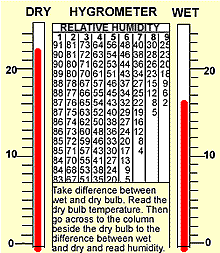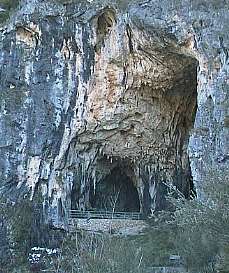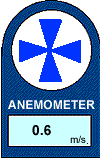Ecosystems at Risk: Limestone caves
3b. Climate of the entrance ecosystem
|
 Hygrometers
allow the relative humidity to be calculated. The dry bulb thermometer
is just a normal thermometer recording air temperature. The wet bulb
thermometer has a wet cloth around the bulb. As this moisture evaporates,
it cools the thermometer. To calculate the relative humidity, get
the difference in temperature between the dry and wet bulb, in this
case about 70C. Then go to the dry bulb temperature at
it's reading of 220C. and go across to column 7 at the
top of the table. The relative humidity is 38%. Hygrometers
allow the relative humidity to be calculated. The dry bulb thermometer
is just a normal thermometer recording air temperature. The wet bulb
thermometer has a wet cloth around the bulb. As this moisture evaporates,
it cools the thermometer. To calculate the relative humidity, get
the difference in temperature between the dry and wet bulb, in this
case about 70C. Then go to the dry bulb temperature at
it's reading of 220C. and go across to column 7 at the
top of the table. The relative humidity is 38%. |
|||
|
Instruments Light meters record light intensity in lux. Anemometers record wind speed. In this case the wind is blowing out of the cave entrance.The speed is recorded in metres per second.
|
| climate twilight |



